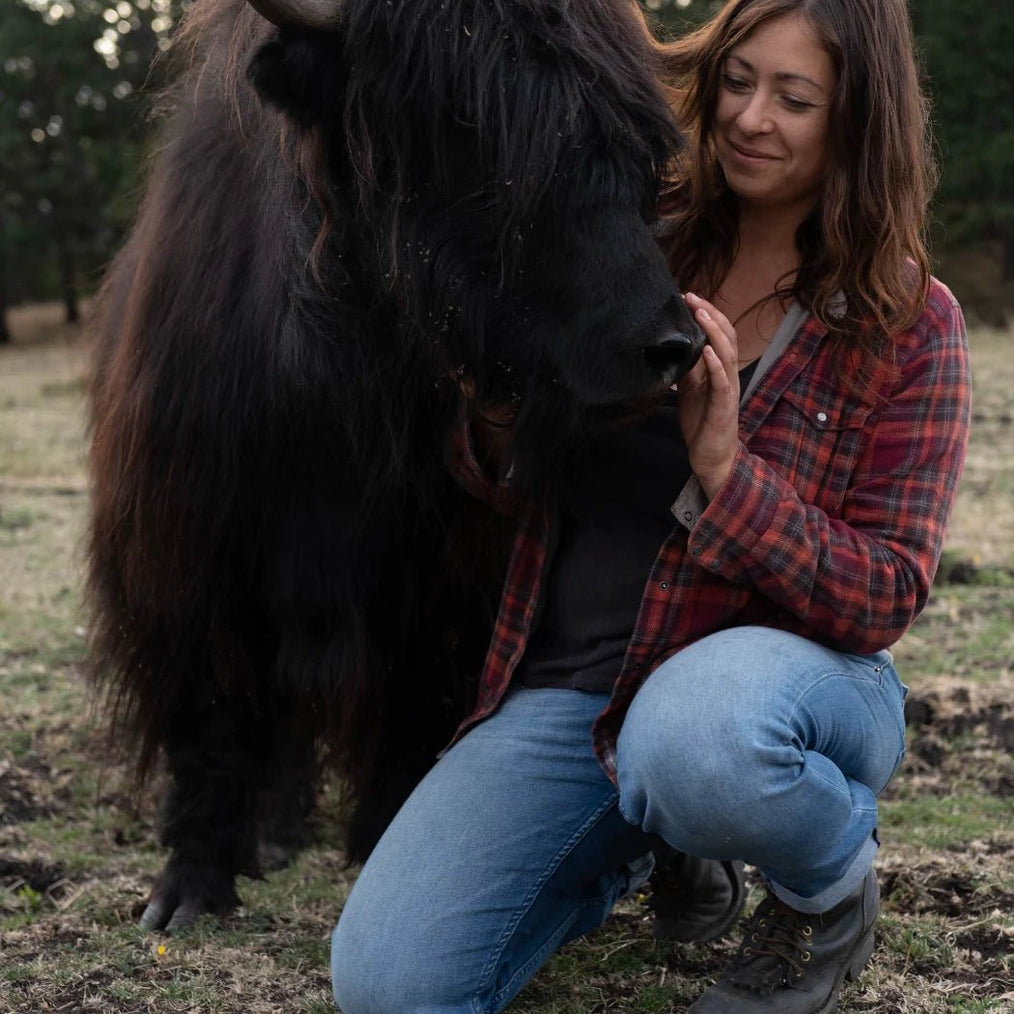Are yaks kind of like Buffalo?
Yaks and Bison are two different species. Bison have the Latin name Bison bison (amazing, really) and yaks are Bos grunniens. Bison are native to North America and are a historically wild animal, and yaks are from Asia. While yaks are a primitive species, they are domesticated and much easier to raise than bison. They are smaller, more efficient in their rumen and lighter on the land, lending themselves well to small farms and ranches. Bison traditionally roam on millions of acres and have a great value to the ecology of the Great Plains, but can be challenging to raise in smaller holdings. Read more about yaks HERE (link)
Can you raise yaks like cattle?
Many ranchers raise both yaks and cattle, and run them similarly. Yaks are smarter and faster than cattle, but they can be managed with similar techniques and in the same operations as cattle.
How do you tell them apart?
People who visit our herd often wonder how we tell them apart from one another. There are always a few that look similar, but there are key differences and once you spend time with yaks, you will see it too!
Are there different breeds of yaks?
So, domestic yaks are a species rather than a breed. The confusion often arises when we talk about phenotypes. Yaks have different phenotypes, which make them look very different from one another, and in certain breeding programs, there may be only one, like super wooly, for example. Read more HERE (link).
Where can I get yak milk?
Unless someone has begun a commercial milk operation since writing this, the best way to get yak milk is to raise some tame yaks and milk them yourself. They do not produce a large quantity of milk like domestic dairy cattle and it is often not viable for ranchers to milk their herd. Read more on yak milk HERE (link).
Do yaks forage or graze?
While yaks are very hardy and adaptable, they are a grazing animal, unlike goats who will eat down brush and understory much more reliably. Yaks will nibble on many things, but it is unrealistic to expect them to clear land or get their nutritional needs met if they do not have adequate access to pasture and grasses.
Can you raise yaks anywhere in the US?
Yaks do best in climates with seasonality and colder winters. They do not perform well in areas with both humidity and high summer temperatures.
How many yaks can I run per acre?
It is generally considered that the stocking rates for yaks are 2 to 1 compared to cattle. However, this will ultimately depend on the specific property, amount of available forage, quality of feed, pasture rotation, irrigation or dryland pasture and ability to supplement feed.
Are yaks safe around predators?
In Tibet, their main natural predator is the Tibetan Wolf. Here in the US, yaks are generally good at defending themselves but their offspring can be attacked by wolves and young stock can be taken by mountain lions. They generally don’t care about coyotes or other predators.
Can I raise yaks with my other animals?
That will ultimately depend on your animals, the size of the property and the temperament of the yaks. Some people successfully raise yaks with sheep, goats, horses, etc, but there are also sad stories of unsuccessful situations. Plenty of space and access to food are important to avoid issues, but it is generally not recommended as a main plan.
Shoot! I need a chute?
Yes! We highly recommend you have the ability to work your yaks, whether it be grooming or healthcare. There are simple, inexpensive designs but it is important to make a chute part of your plan. Read more HERE (link).
Do I really need a scale?
If you have a couple pet yaks and keep them in good health, chances are you don’t need a scale. But if you are raising yaks for meat, have a herd and want to ensure productivity and health, a scale is an invaluable tool. There are simple and inexpensive options online for putting one together at home. If you are launching a larger herd, definitely look into options that have a computer interface to upload weights and track productivity.
How many yaks should I get to start?
That depends on your goals, how tame you want them and how quickly you want to produce offspring. We generally recommend beginning with between 2 and 7 yaks, but if you are starting a meat production herd, you may want more.
Can I breed yak cows to my beef bull?
It is generally not recommended to breed yak cows to other bovines. Yaks have much smaller birth weights and larger calves can be hard on the yak cows. While it has been done successfully, it can lead to more birth and post-birth complications. If you want to cross breed, consider getting a young yak bull and raising him with beef cows to breed when he is mature.



